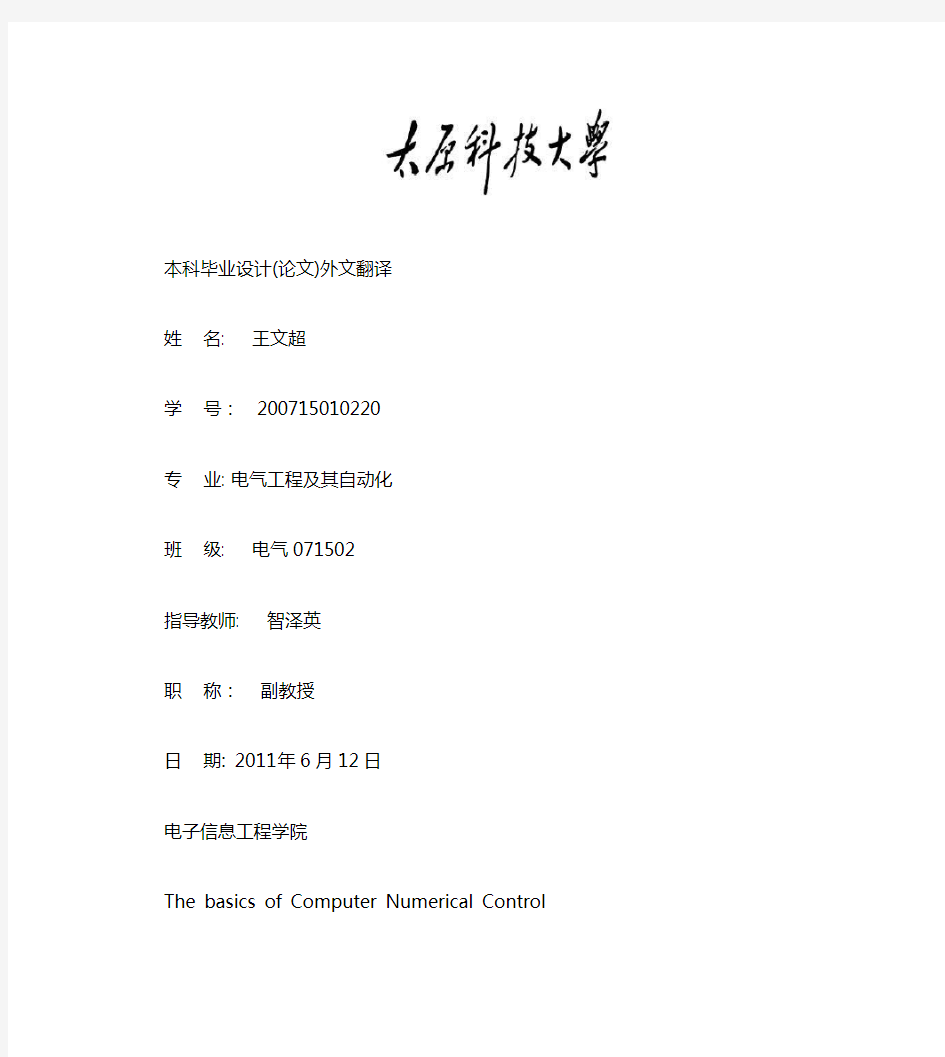英文文献科技类原文及翻译


本科毕业设计(论文)外文翻译
姓名: 王文超
学号: 200715010220
专业: 电气工程及其自动化
班级: 电气071502
指导教师: 智泽英
职称:副教授
日期: 2011年6月12日
电子信息工程学院
The basics of Computer Numerical Control
While the specific intention and application for CNC machines vary from machine type to
another, all forms of CNC have common benefits. Though the thrust of this presentation is to teach you CNC usage, it helps to understand why these sophisticated machines have become so popular. Here are but a few of the more important benefits offered by CNC equipment.
The first benefit offered by all forms of CNC machine tools is improved automation. The operator intervention related to producing workpieces can be reduced or eliminated. Many CNC machines can run unattended during their entire machining cycle, freeing the operator to do other tasks. This gives the CNC user several side benefits including reduced operator fatigue, fewer mistakes caused by human error, and consistent and predictable machining time for each workpiece. Since the machine will be running under program control, the skill level required of the a CNC operator (related to basic machining practice) is also reduced as compared to a machinist producing workpieces with conventional machine tools.
The second major benefit of CNC technology is consistent and accurate workpieces. Today’s CNC machines boast almost unbelievable accuracy and repeatability specifications. This means that once a program is verified, two, ten, or one thousand identical workpieces can be easily produced with precision and consistency.
A third benefit offered by most forms of CNC machine tools is flexibility. Since these machines are run from programs, running a different workpiece is almost as easy as loading a different program. Once a program has been verified and executed for one production run, it can be easily recalled the next time the workpiece is to be run. This leads to yet another benefit, fast change-overs. Since these machines are very easy to setup and run, and since programs can be easily loaded, they allow very short setup time. This is imperative with today’s Just-In-Time product requirements.
1. Motion control-the heart of CNC
The most basic function of any CNC machine is automatic, precise, and consistent motion. Rather than applying completely mechanical
devices to cause motion as is required on most conventional machine tools, CNC machines allow motion control in a revolutionary manner. All forms of CNC equipment have two or more directions of motion, called axes. These axes can be precisely and automatically positioned along
their lengths of travel. The two most common axis types are linear (driven along a straight path) and rotary (driven along a circular path).
Instead of causing motion by turning cranks and handwheels as is required on conventional machine tools, CNC machines allow motions to be commanded through programmed commands. Generally speaking, the motion type (rapid, linear, and circular), the axes to move, the amount of motion and the motion rate (feedrate) are programmable with almost all CNC machine tools.
Accurate positioning is accomplished by the operator counting the number of revolutions made on the handwheel plus the graduations on the dial. The drive motor is rotated a corresponding amount, which in turn drives the ball screw, causing linear motion of the axis. A feedback device confirms that the proper amount of ball screw revolutions has occurred.
A CNC command executed within the control (commonly through a program) tells the drive motor to rotate a precise number of times. The rotation of the drive motor in turn rotates the ball screw. And the ball screw causes drives the linear axis. A feedback device at the opposite end of the ball screw allows the control to confirm that the commanded number of rotations has taken place.
Though a rather crude analogy, the same basic linear motion can be found on a common table vise. As you rotate the vise crank, you rotate a lead screw that, in turn, drives the movable jaw on the vise. By comparison, a linear axis on a CNC machine tool is extremely precise. The number of revolutions of the axis drive motor precisely controls the amount of linear motion along the axis.
How axis motion is commanded-understanding coordinate systems. It would be infeasible for the CNC user to cause axis motion by trying to tell each axis drive motor how many times to rotate in order to command a given linear motion amount. (This would be like having to figure out how many turns of the handle on a table vise will cause the movable jaw to move exactly one inch!) Instead, all CNC controls allow axis motion to be commanded in a much simpler and more logical way by utilizing some form of coordinate system. The two most popular coordinate systems used with CNC machines are the rectangular coordinate system and the polar coordinate system. By far, the move popular of these two is the rectangular coordinate system, and we’ll use it for all discussions made during this presentation.
